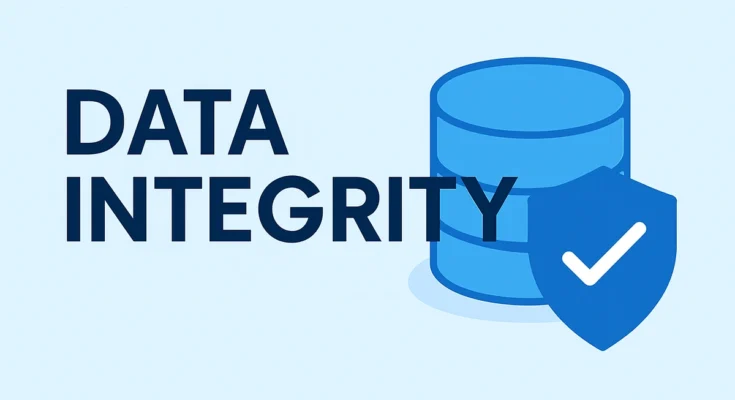Introduction to Data Integrity in Financial Operations
What is Data Integrity?
Whether it’s a single invoice or a complex ledger entry, if the statistics are flawed at the start, the whole thing downstream becomes questionable. We improved our accounts payable process by implementing invoice data capture software to automatically extract and organize invoice details with greater speed and accuracy.
Think of it like building a skyscraper on a cracked basis. Even the most advanced economic systems can’t function optimally if the base input data is corrupt. Without robust facts integrity, groups open themselves up to miscalculations, regulatory headaches, and a whole erosion of credibility in their reporting.
Why It Matters in Financial Operations
In economic operations, each figure topic. A single out-of-place decimal or an incorrectly entered bill can snowball into significant losses or compliance violations. Data integrity is the difference between confident choice-making and reactive firefighting.
For CFOs, controllers, and finance groups, fact integrity ensures:
- Accurate economic reporting
- Streamlined audits
- Compliance with nearby and worldwide guidelines
Informed forecasting and strategic planning
More importantly, when integrity is ensured from the point of data capture, companies reduce the burden of corrections and rework, saving both time and money. Financial departments can then focus on analysis and strategy instead of being trapped in error-hunting loops. Our finance team reduced manual data entry errors by 80% after switching to an advanced invoice data capture software solution.
The Crucial Role of the Input Layer
Understanding the Input Layer in Financial Processes
The “enter layer” in financial operations refers to the preliminary segment wherein facts first enter your economic machine. Think scanned invoices, PDF payments, emailed purchase orders, or even manually typed entries into an accounting software program.
Whether you’re coping with Accounts Payable (AP) or Accounts Receivable (AR), the entry layer is your first line of defense against data decay. And yet, it’s regularly ignored.
Companies may also invest in high-end analytics equipment or robust ERP platforms, but forget about the starting point: How smooth is the transition into? It’s like feeding rotten elements into a 5-star kitchen—you mayn’t expect a gourmet dish to come out.
With finance turning into increasingly virtual and global, the extent of data entering via the enterprise layer has exploded. This has raised the stakes: the greater the number of sources you have, the greater the possibilities there are for record inaccuracies.
Common Input Layer Weaknesses
Most economic data errors trace back to 3 predictable weaknesses within the input layer:
Manual Data Entry: Still extensively utilized in small and mid-sized groups, which is one of the main reasons for human error.
Poor Integration: Siloed structures that don’t communicate nicely can result in inconsistent or lost records at some point of transfer.
This is where bill information capture software steps in as a game-changer. It addresses these problems by automating, standardizing, and validating facts. For the time being, it enters the monetary ecosystem.
Real Cost of Poor Data Integrity
Operational Inefficiencies
Poor information integrity forces groups to become part-time detectives digging through spreadsheets, double-checking records, and resolving discrepancies. It results in:
- Reprocessing of payments
- Missed price closing dates
- Vendor dissatisfaction
- Reconciliation nightmares
These inefficiencies not only drain the workforce but also kill momentum. The finance group, which must be driving strategic selections, is slowed down by clerical grunt work.
Compliance and Audit Risks
Regulatory compliance hinges on clean, traceable records. Auditors don’t simply observe reports; they examine how that information was generated and captured.
Any destruction within the audit trail or inconsistency in monetary documentation can raise red flags. In worst-case scenarios, groups face:
- Penalties and fines
- Failed audits
- Legal scrutiny
- Loss of credibility with stakeholders
Strong facts capture practices that put in place validation at the entry level considerably reduce those dangers. With the correct bill records capture software program, each piece of statistics will become a part of a confirmed and traceable path.
Business Decision-Making Impairments
Without data integrity, your dashboards lie. Your forecasts are guesses. Your KPIs become noise instead of signals.
The Evolution of Invoice Data Capture Software
Traditional vs. Modern Methods
With invoice data capture software, businesses can extract key details like vendor names, invoice numbers, and payment terms instantly from scanned documents. Traditionally, invoice processing turned into a guide, repetitive, and paper-heavy. AP groups might:
- Receive paper invoices by mail
- Manually key in data to spreadsheets or ERP structures
- Cross-check line gadgets against POs
- Route invoices for approval through email or print
- This system became slow, error-prone.
Too expensive, head-wondering companies are adopting clever invoice information seize software that automates the entire front end of bill processing.
Modern gear doesn’t simply examine textual content; it recognizes context, validates values, or even analyzes through the years. They can handle numerous codecs, including:
- PDFs
- Scanned photos
- Email attachments
- EDI documents
More importantly, they can extract more than one record factor, including:
- Vendor call
- Invoice range
- Line-object info
- Tax quantities
- Due dates
This shift to automation represents a fundamental improvement in how data integrity is preserved from the instant it enters the economic workflow.
Conclusion
In the virtual age of finance, information integrity isn’t a luxury it’s a need. And the only way to steady it is by starting at the source: the input layer. By enforcing clever bill information capture software, groups can transform a traditionally error-prone, manual system into an automatic, intelligent, and seamless workflow.




